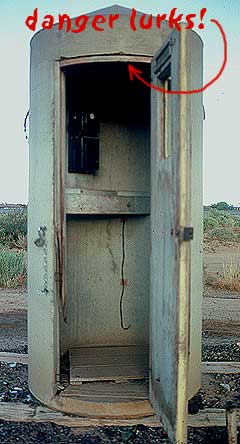HOW TO CALL THE SP DISPATCHER
A career ago, I took promotion to conductor at Bayshore Yard, and the only question asked of me during the oral examination was: Where can you find a company officer 24 hours per day? I admitted that I was stumped, not saying that I believed that most managers kept bankers' hours. The correct answer was: at the chief dispatcher's office.
This was all well and good, I responded, but what do I do in that moment of dire necessity that comes when I'm out of Motorola radio range from the chief? The officer allowed that I was probably out of luck, but added that, We still have some call booths, I think.
Yes, those concrete outhouses (literally - for the homeless) still littered the Coast Division in profusion, most of them being many years past their originally intended function. I never found one in operating condition , until I transferred to Tucumcari, New Mexico in 1984. There, most sidings still featured a telephone booth at one end, all supposedly connected to the dispatcher in Tucson.
As things seldom went as planned out of Tucumcari, crews had frequent cause to contact the dispatcher to revamp game plans. After the demise of train order dispatching at mid-year, everything was handled via radio, using the same crummy Motorolas that were the bane of railroaders everywhere. The extra bonus was that this portion of New Mexico is hill-'n-dale, replete with dead spots where even the best radios are useless.
So, when a crew was out of running authority and out of radio range, what could they do in those days before cell phones and better radio setups?
- First, have the caboose try their radio.
- Second, take the radio handset on the lead loco back through the units in a search for a more powerful transmitter (HAH!).
- Third, move the train ahead, or back, out of the dead spot.
- Fourth, if there is one, use the call booth:
In doing so, Sammy mentioned the cause of his phobia. Early in his career (a.k.a., steam engine days), Sammy had passed through a booth doorway without taking precautions, only to have a live rattler drop off of the door frame onto his head! Thus, after cracking the door and throwing in the fusee to gas the wildlife, beyond giving sufficient time for the fumes to do their work, the main thing was that, prior to entry, you always used a stick or something to dislodge snoozing snakes from above the doorway.
After that, I was on my own to decipher how that particular phone's wires were crossed to alert the dispatcher. The Spring 2004 issue of the SPH&T Society's SP Trainline has a nice little article by Frank Scheer about the concrete booths, that includes a discussion of phone operation (this would have been handy twenty years ago, Frank!), but the bottom line was always that the batteries used for transmitting were invariably dead. You could hear the dispatcher discussing his bowling scores with some conductor somewhere, but no matter if you screamed until the booth cracked, there was no way that the guy was going to hear you. This leads us to:

- Fifth, decide if you are going to wait it out until another train comes along to relay your grief, or if you want to walk a mile down to the highway in the rain to hitch a ride with a rancher to a nearby (definition: within five miles) phone. Of course, you don't have Tucson's number, so you call the Tucumcari yard office...
I should note here that twenty years hence, on a railroad that is less than 50 miles long, I sometimes wish for the reactivation of the concrete bunkers, because those stupid Motorolas still don't work worth a darn. But hey, overtime pays the most!
